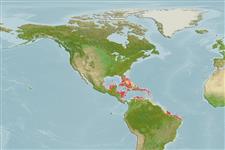>
Blenniiformes (Blennies) >
Labrisomidae (Labrisomids)
Etymology: Paraclinus: Greek, para = the side of + Greek, klinein, kline = sloping and bed, due to the four apophyses of sphenoid bone (Ref. 45335).
More on author: Steindachner.
Environment: milieu / climate zone / depth range / distribution range
экология
морской ассоциированный с рифами; пределы глубины 0 - 6 m (Ref. 9710). Tropical
Western Central Atlantic: southern Florida, USA and the Bahamas to Central America and northern South America; absent in the Antilles, except for Cuba.
Size / Вес / Возраст
Maturity: Lm ? range ? - ? cm
Max length : 10.0 cm TL самец/пол неопределен; (Ref. 7251)
Краткое описание
морфология | морфометрия
колючие лучи спинного плавника (общее число): 28 - 29; членистые (мягкие) лучи спинного плавника (общее число): 1; колючие лучи анального плавника 2; членистые (мягкие) лучи анального плавника: 19 - 20
Inhabits seagrass beds and coral reefs. May be found associated with the sponge Verongia fistularis (Ref. 13628). Sexual dimorphism in the shape of the head and dorsal fin (Ref. 5521). Oviparous (Ref. 205). Polygynous males guard the eggs which are spawned by several females in nests (Ref. 55842).
Life cycle and mating behavior
половая зрелость | размножение | нерест | икра | Fecundity | личинки
Females deposit eggs in nests often associated with the sponge Verongia fistularis (Ref. 55842). Males fan the eggs for aeration which are probably spawned by several females owing to different developmental stages of eggs present in the nests (Ref. 205). Pairs will spawn routinely in aquaria in the absence of the sponges (Ref. 205).
According to aquarium observations by Breder (1941), "spawning takes place with the female in an inverted position while the male remains upright, wandering females adding to the eggs. The nesting male on sexual exhaustion repulses additional females with a typical warning attitude and eventual biting similar to its reaction to another male or other fish."
Robins, C.R. and G.C. Ray, 1986. A field guide to Atlantic coast fishes of North America. Houghton Mifflin Company, Boston, U.S.A. 354 p. (Ref. 7251)
Статус Красного Списка МСОП (Ref. 130435)
Угроза для людей
Harmless
Использование человеком
аквариум: коммерческий
дополнительная информация
Возраст/РазмерыростЗависимость между длиной и массой телаЗависимость между длинамиРазмерный составморфометрияморфологияличинкидинамика численности личинокпополнениечисленностьBRUVS
ссылкиаквакультура (рыбоводство)особенности рыбоводствастепень растяжениягенетикаElectrophoresesнаследуемостьболезниобработкаNutrientsMass conversion
соавторыизображенияStamps, Coins Misc.звукиCiguateraскоростьтип плаванияжаберная областьOtolithsмозгзрение
инструменты
Специальные отчеты
Скачать в формате XML
ресурсы в Интернет
Estimates based on models
Preferred temperature (Ref.
123201): 23.8 - 28.2, mean 27.3 °C (based on 640 cells).
Phylogenetic diversity index (Ref.
82804): PD
50 = 0.5000 [Uniqueness, from 0.5 = low to 2.0 = high].
Bayesian length-weight: a=0.00912 (0.00399 - 0.02083), b=3.06 (2.87 - 3.25), in cm total length, based on LWR estimates for this (Sub)family-body shape (Ref.
93245).
Trophic level (Ref.
69278): 3.7 ±0.4 se; based on size and trophs of closest relatives
Fishing Vulnerability (Ref.
59153): Low vulnerability (10 of 100).
Nutrients (Ref.
124155): Calcium = 117 [65, 212] mg/100g; Iron = 0.788 [0.459, 1.317] mg/100g; Protein = 18.9 [17.8, 19.9] %; Omega3 = 0.137 [0.080, 0.231] g/100g; Selenium = 16.5 [8.1, 32.6] μg/100g; VitaminA = 177 [58, 550] μg/100g; Zinc = 2.07 [1.39, 2.93] mg/100g (wet weight);
